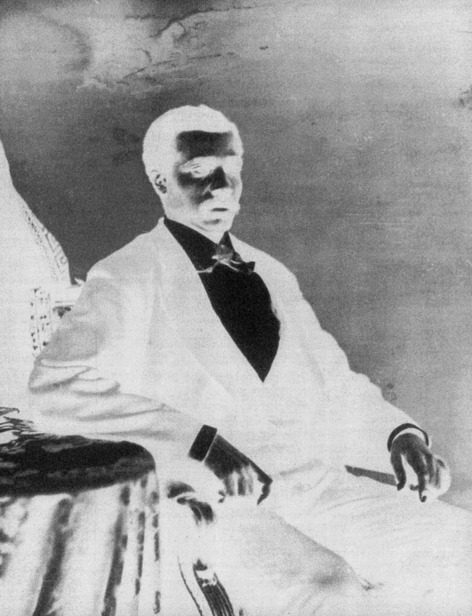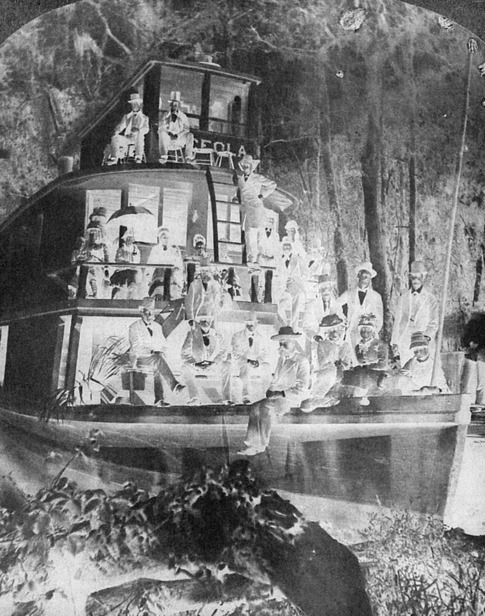The History of Florida (56 page)
Read The History of Florida Online
Authors: Michael Gannon
Tags: #History, #United States, #State & Local, #Americas

infinitely better than it was to be for the next seventy-five years.”
headed by Harrison Reed, Wil iam H. Gleason, and Thomas W. Osborn,
among others, took a more moderate position. They realized that congres-
sional requirements would have to be met, but they were more interested in
developing the vast vacant lands of the state. They were willing to include
blacks in the new electorate, but they also wanted the native whites to par-
ticipate in the new government.
The Republicans elected nearly al of the forty-three delegates to the
convention, which met in January 1868, but they were varying kinds of
266 · Jerrell H. Shofner
Republicans. The Radical Republican Billings-Richards faction was able to
control the organization of the convention and seemingly would be able to
write a constitution suitable to them. White delegates sympathetic to Reed
and Gleason bolted the convention and wrote a contesting document with
the cooperation of Charles E. Dyke and McQueen McIntosh, both of whom
represented the native white leadership of the state. They then returned to
Tal ahassee in the middle of the night, took possession of the assembly hal ,
and reorganized the convention while the Billings-Richards delegates slept.
The Radical delegates were dumbfounded that fol owing morning to find
themselves locked out of the assembly hal by a cordon of U.S. soldiers.
After several stormy days and some amazing decisions by Congress, the
moderate version of the constitution—despite its unorthodox origin—was
sent to the pol s and approved by Florida voters. Harrison Reed was elected
governor and William H. Gleason lieutenant governor. At a Fourth of July
ceremony, Colonel John T. Sprague, commander of the occupation force,
relinquished authority to Governor Reed. Radical Reconstruction had led
to a constitution which, according to the new governor, would “prevent a
Negro legislature.”3
Reed’s was a stormy administration. In his continuing effort to retain
the support of native whites for the new government, he appointed Robert
proof
Gamble and James Westcott to cabinet positions, but that move backfired
when Gamble openly opposed Reed’s deficit financing plans. Having sup-
ported him against the Billings-Richard faction, Charles E. Dyke now lev-
eled the powerful guns of his
Tal ahassee
Floridian
against the governor in
particular and all Republicans in general. A sizable minority of native white
legislators calling themselves Conservatives used their votes in the legisla-
ture to thwart Reed and embarrass the new Republican Party. Attempting
to tread the narrow path between Conservatives on one hand and black leg-
islators on the other, the governor angered both. His ambitious lieutenant
governor was not much help either: Gleason supported a move to impeach
Reed and remove him from office. The wily governor bested him, retained
his office, and strengthened his position by appointing Jonathan C. Gibbs,
a capable and influential black, as secretary of state. Gleason subsequently
turned his considerable abilities to developing vacant lands in peninsular
Florida and founding the town of Eau Gallie on the Indian River.
While Conservative editors and legislators fought Reed in Tal ahassee,
others took more direct action in the outlying areas. Control ing most of
the land and credit, Conservative planters and merchants denied credit
and land rentals to freedmen who continued to vote the Republican ticket.

proof
Born a slave in Virginia, Josiah T. Walls served in the Union army and settled in Florida
after Appomattox. Aided by Republican Reconstruction politics, he entered public life
as a state representative and senator. Then, in 1870, he became Florida’s first African
American member of the U.S. House of Representatives, to which he was elected twice
more. Following politics he turned to truck farming. Other black politicians in Florida
during the 1870s were John Wallace, Henry Harmon, Charles Pearce, Robert Meacham,
and the Dartmouth-educated Jonathan Gibbs, who became secretary of state under
Governor Harrison Reed (1868–73).
268 · Jerrell H. Shofner
Vigilantes such as the Ku Klux Klan and the Young Men’s Democratic Clubs
used violence and intimidation to discourage or prevent newly enfranchised
blacks from exercising their voting privileges. Leaders were threatened,
beaten, and kil ed. Pol ing places were disrupted by gunfire and threats.
Former Confederate cavalry commander J. J. Dickison even led bands of
mounted men in cavalry charges through crowds of potential voters. With-
out financial and personnel resources, Reed was obliged to rely on the U.S.
Army garrison to maintain order. But its numbers were smal , it was far
removed from the many scenes of violence, human life was lightly regarded,
the stakes were high, and the violence continued.
Congress ultimately responded with legislation empowering the pres-
ident to restore martial law, but violence and disorder remained serious
problems during most of Reed’s four and a half years in office. Intraparty
factionalism and repeated impeachments of the governor, some of which
were inspired and encouraged by U.S. Senator Thomas W. Osborn, kept
the state in turmoil and discredited both the Reed administration and the
Republican Party.
While Reconstruction brought unwelcome changes and political and
racial strife to the Middle Florida plantation belt, it concomitantly helped
to open up peninsular Florida to settlement. Until the 1860s the Florida
proof
peninsula had been a sparsely populated cattle range where drovers grazed
their herds over miles and miles of open range. When Wil iam Gleason
accompanied Freedmen’s Bureau agent George F. Thompson on a tour of
southern Florida in 1865–66, they reported vast open lands and a balmy
climate—only the first of many touting the Florida peninsula to receptive
audiences across the nation. Northerners were attracted by available open
land where the winters were mild. Southerners liked the idea of an unsettled
region where they could escape the conditions of Reconstruction.
Soon magazines, newspapers, and railroad companies were sending re-
porters to observe and report on this paradise. By 1870 Floridians were pub-
lishing the
Florida
New
Yorker
to attract settlers and investors. Jacksonville,
which had been almost destroyed by the frequent invasions of the war years,
bounced back to become the center of winter tourism, the gateway to south-
ern Florida via the St. Johns River, and a budding financial center where
northern capital was increasingly available for investment. Hubbard Hart’s
line of steamers was one of several which carried passengers and freight up
the St. Johns. He and others made a tourist attraction of Harriet Beecher
Stowe’s winter home at Mandarin, easily visible to passengers eager to catch
a glimpse of the lady who Abraham Lincoln had once credited with starting

proof
President and former Union general Ulysses S. Grant (
seated,
left
front
) and a party of
northern friends journey down Florida’s most picturesque river, the Ocklawaha, on
the paddle steamer
Osceola.
Similar steamboats plied the St. Johns, Suwannee, and
Apalachicola Rivers. One nervous passenger on the Ocklawaha recorded: “The hull of
the steamer went bumping against one cypress-butt, then another, suggesting to the
tyro in this kind of aquatic adventure that possibly he might be wrecked, and sub-
jected, even if he escaped a watery grave, to a miserable death, through the agency of
mosquitoes, buzzards, and huge alligators.”
270 · Jerrell H. Shofner
the Civil War. But Hart also added a popular tourist attraction by opening
up the Ocklawaha River to Silver Springs, which by 1873 was being visited
by 50,000 tourists annual y.
Frederick DeBary, a Belgian wine merchant, also transported visitors
up the St. Johns as far as Lake Monroe, where he built a hotel at the new
community named for him. The Brock Line operated between Jacksonville
and Enterprise on the northern shore of Lake Monroe. Small shallow-draft
steamers plied the tortuous channels of the upper St. Johns with passengers
and cargo bound for the Indian River settlements of Titusville, Rockledge,
and Eau Gallie. With three large hotels, Rockledge soon became known as
the southernmost winter resort in the nation.
One of the Yankees who invested largely in peninsular Florida was Henry
S. Sanford, a former Union general and powerful member of the national
Republican Party. He founded the town of Sanford about 1870 on Lake
Monroe’s south shore. Using both Swedish immigrant and native black la-
bor, he developed two large orange groves. He also sold numerous tracts to
other northerners, among whom were Wil iam Tecumseh Sherman, Senator
Henry Anthony of Rhode Island, and Orvil e Babcock, personal secretary to
President Grant. With Sanford’s vigorous support, several Boston investors
started the South Florida Railroad to run southward through Orlando to
proof
Kissimmee, thus opening more of the peninsula to settlers. President Grant
was induced to turn the first shovel of earth in 1879.
In the absence of suitable transportation, settlement of the western part
of the peninsula lagged behind the St. Johns River val ey, but Tampa boasted
a few hundred inhabitants near the old Fort Brooke army reservation in
the early 1870s. A colony of “Downeasters” settled at Sarasota in 1868, and
tourists were able to find lodging at several locations in Manatee County by
the early 1870s. Jacob Summerlin, Zibe King, Francis A. Hendry, the Curry
family, and others continued grazing their herds uninterrupted on the south
Florida range, but the citrus and tourist industries were already on their way
during the Reconstruction years.
The missing link was suitable railroad transportation, but the state’s In-
ternal Improvement Fund was unable to use its millions of acres of public
lands as incentive to potential builders because of a complicated lawsuit
that prevented it from conveying clear titles. Efforts in 1866 to revive the
war-damaged Florida Railroad from Fernandina to Cedar Keys had resulted
in a federal court injunction prohibiting sale of state lands except for cash.
Unable to effect such a sale, the state could not clear the so-called Vose in-
junction until 1881. The Reed administration assisted Milton Littlefield and
Reconstruction and Renewal, 1865–1877 · 271
George W. Swepson with their Jacksonville, Pensacola, and Mobile Railroad
venture, but that firm also became embroiled in litigation which was not
settled until 1879. Railroad construction in Florida had to wait until the
1880s.
Events surrounding the Jacksonvil e, Pensacola, and Mobile Company
were catalysts for one of the four attempts to remove Governor Reed from
office by impeachment. These internecine squabbles added to the confusion
that brought Reed’s administration to an end in 1873. A fractious Republi-
can convention bypassed him in 1872 and nominated for governor Ossian
B. Hart, the native Florida Unionist who had good relations with black lead-